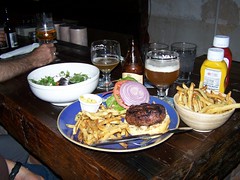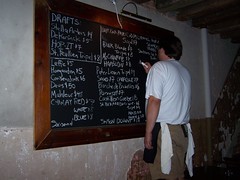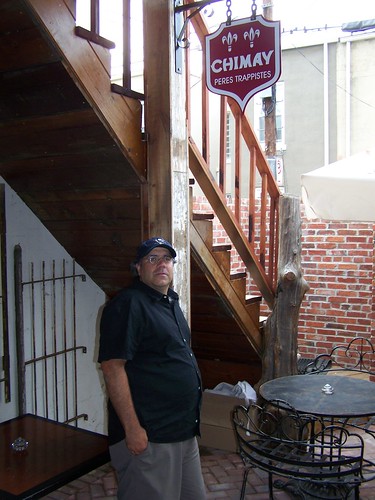Revitalizing urban commercial districts requires many things

Damn good food and drink, Dr. Granville Moore's, H St. NE
but it all comes down to attracting customers that are willing to spend money--enough money on goods and services so that businesses can pay their rent, employees, and make a profit. And when the rents are paid, the buildings can be maintained. When many businesses are successful, it's easier to attract additional businesses to vacant buildings. It's a mutually reinforcing circle.
In short you need (a lot of) customers. And customers need a reason to come and a reason to spend money.
Similarly, I've been thinking more and more about dayparts, stages in commercial district revitalization, and Jane Jacobs principle about "mixed primary uses"
From "Old Oakland becoming the place to be once again: New bars and eateries revitalize area's nightlife," from the Oakland Tribune (courtesy of DC1974):
Anchors of the first wave that finally got going in the late 1980s — the Pacific Brewing Co. (1988) and, later, Le Cheval — are still going strong. Others didn't make it when the Old Oakland energy started to sputter. It was looking pretty bad by the early 2000s, despite the hopping Farmers Market, Cafe 817 and G.B. Ratto's International Market — all of which closed by sundown. Nearby restaurants didn't stay open much later.
It was like natural selection for entertainment spots. The weak gave way, to be replaced by a new species of eateries and bars. Overall, 20 businesses have opened in the area in recent years, said Oakland's marketing manager, Samee Roberts.
Creating a night life to attract a younger crowd was the key to surviving since 2000, said Ken Ham, owner of the Grand Oaks Grill and Bar on Washington Street at the lower end of Old Oakland's borders (7th to 10th streets between Broadway and Jefferson).
Catering to the lunch crowd from the nearby shops and offices puts money in the till. But it's booze that turns a real profit.

Writing the list of beers on the chalkboard on opening night, Dr. Granville Moore's.
I wrote a blog entry a few days ago about the new Dr. Granville Moore's on H Street, but the computer crashed... but that place illustrates the importance of creating a destination--they have excellent Belgian beers, more than 50, each with a special glass, and excellent food, focusing on moules and frites, but including fine salads, burgers, risotto, and other items.
I think it proves the point made in Richard's Rules for Restaurant Driven Revitalization that restaurants in places unable to attract customers from outside the immediate area have to have a more general cuisine. But if you are part of a destination, your business can be more specialized and become a destination in its own right. (Which illustrates Jacobs' point about places with density being able to have and support a more diverse array of choices.)
From the article:
The fringes of Old Oakland still look mangy, especially at night. The CityTeam homeless shelter has held on through it all, against the forecast years ago that it would be pushed out as the area went hip. Now city officials want to lure residents to the area. That's the impetus behind building a slew (567 to be exact) of housing units on the borders of the area. More residents (1,000 as a result of the new units) equals more business is the basic idea.
Meanwhile, Ham is toying with the idea of turning his place into a sports bar, instead of a bar and grill. "Creating night life brings people in. More people make it feel safer," he said. "The area is coming along."

Joe Englert's decision to open taverns, music places, and related establishments in a three block area of H Street NE (note that this distance is equivalent to 6 blocks in length, one block is double sized the normal DC block, another is triple sized)--all with interesting concepts providing reasons for people to visit, consume (spend money), and come back again has accelerated the revitalization of the H Street commercial district by 5 to 7 years (in my opinion).
Labels: commercial district revitalization, restaurant, retail, urban revitalization



0 Comments:
Post a Comment
<< Home